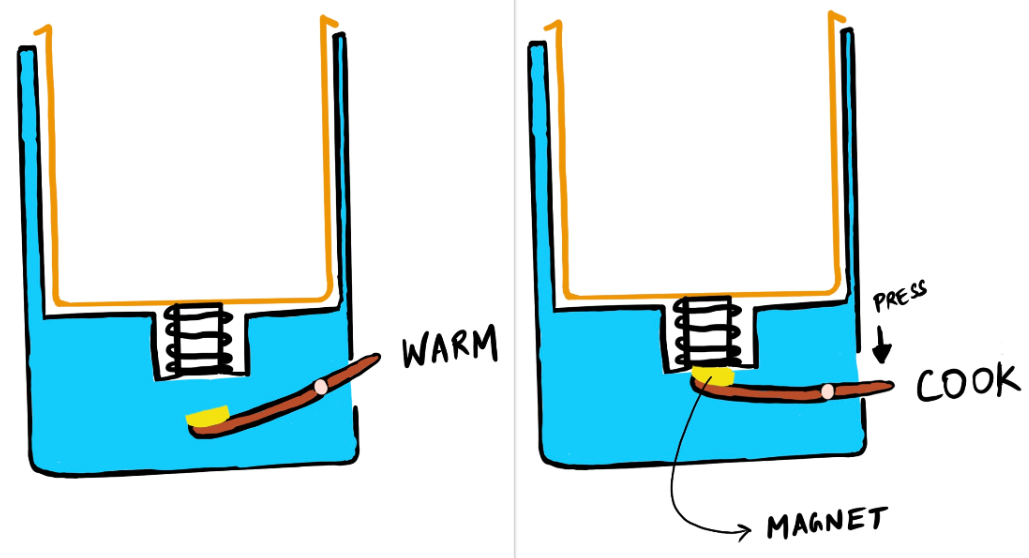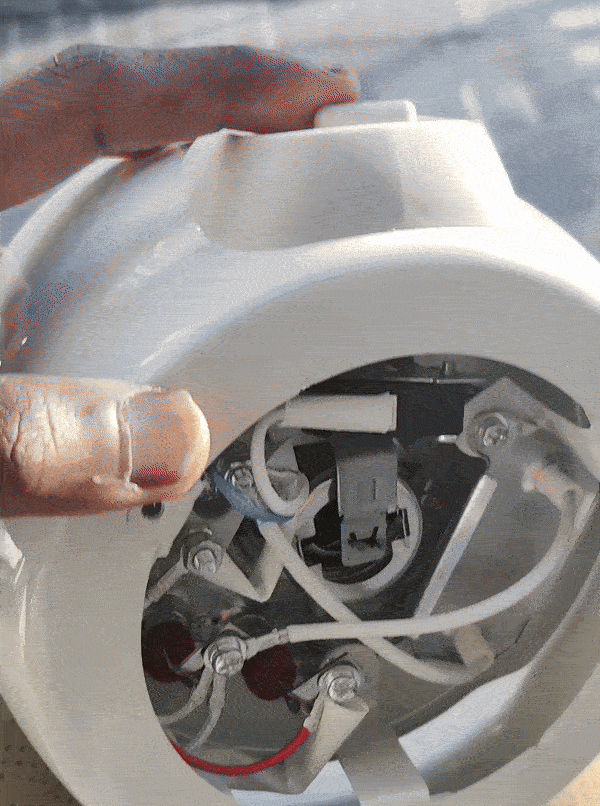How does your Rice cooker work?
Hey friends, Happy Wednesday!
Thank you all for making this newsletter cross 500 days last week. It wouldn’t have been possible without your constant support, and this means a lot to me.
Let’s look at how rice cookers work this week. I use an Instant Pot and never had a rice cooker, so I bought an inexpensive one for the newsletter. I aim to write my newsletter issues in a way one can follow them while traveling on a bus, having a coffee, waiting for food, etc. Let's jump in!
How it works: 15-second answer
Pressing the “Cook” mode button pushes a lever (a magnet holds the lever in place) to change the circuit connection and makes the heating coils supply a lot of heat for the cooking to begin. As the water boils, excess heat converts it to steam, cooking rice. After the water is gone, the rising temperature weakens the magnet and the lever is no more held in place. This stops the heating coils from supplying a lot of heat - transitioning the cooker to “Warm” mode.
Answer to the question I posed last week
Last week, I asked how much data ChatGPT explored to become what it is today. It’s 570GB of text!
Shoutout!
Thanks to Caitlin Olson for recommending this week’s gadget. This is easily one of the most fascinating tech yet simple gadgets I’ve written about. You too can recommend using the links at the end of the email. Please feel free, and I’ll definitely write about it.
How does a rice cooker work?
#1 What happens when you place the vessel in a rice cooker
You fill the rice cooker vessel with some water and rice grains. Now when you place the vessel inside the rice cooker, it’s pushing down a spring-loaded metal block as seen in Figure 1. The coils around the button are heating coils that supply heat to cook the rice. The weight of the vessel pushes and holds the metal block against the spring from pushing it back up.
Figure 1: Spring-loaded metal block and coils around it - inside the rice cooker
#2 What happens when you connect the power cord?
The circuit for supplying heat is complete in “Warm” mode and a very small current is passed so it is not enough to cook.
#3 What happens when you press the button to “Cook” mode?
The following diagram is simplified for easier understanding.
Figure 2: Pressing it into cook mode rotates a lever (brown), and the magnet (yellow) attached to the lever sticks to the bottom of the spring-loaded metal block.
The button to turn on "cook" mode has a lever on the inside that rotates and this changes the circuit connection to pass a very high current for the heating coils to supply heat.
But the lever will simply drop down as nothing is holding it in place if you stop pressing.
So by placing a magnet on the end of the lever, it sticks to the bottom of the metal block that is already pushed down by the vessel.
Hence the lever stays in place and the cooking process starts with the high heat supplied by the heating coils.
#4 What happens during cooking?
Now, the rice cooker is in “Cook” mode. The heat supplied through the heating coils raises the temperature of the water in the vessel and eventually starts boiling at 100 deg C.
Concept #1: Once water starts boiling at 100 degrees C, heat does not increase the temperature of the water further. The excess energy is all spent in converting water into steam. It’s a property of water. Meanwhile, the rice grains are also absorbing water and are being cooked.
All the water is absorbed by the grains or turned into vapor...
Figure 3: Lever in action in response to the button press
#5 How does cooking stop automatically?
Until we had water in the vessel, it was not letting the temperature go beyond its boiling point. Now that it’s all converted into steam or absorbed by the grains, the temperature of the vessel starts increasing further for the first time. At this high temperature, the magnet loses its property of attraction.
Concept #2: In physics, the Curie temperature (TC), or Curie point, is the temperature above which certain materials lose their magnetic properties.
This makes the magnet not hold onto the metal block anymore and drop down along with the lever. This reconnects the circuit to use a low current instead of a high current, thus bringing the rice cooker to “Warm” mode.
The cooking process is now complete, and the rice can be served for lunch.
Additional Info: In warm mode, a resistor with very high resistance is connected. So that’s why we have a low current. But when we press the “Cook” mode button, this high resistance resistor is disconnected and that’s why we have a high current due to Ohm’s law. (Voltage = Current x Resistance)
Question of the week
The heating stops when you remove the vessel while the cooking is in progress. How does this happen automatically? The answer can be derived from what we discussed today. Reply to this email with your thoughts, and I’ll answer this in the next newsletter issue. Thank you.
Gadget of the week
Apple Vision Pro: Apple Vision Pro is a spatial computer that blends digital content and apps into your physical space, and lets you navigate using your eyes, hands, and voice. It has an operating system of its own called visionOS. It’s a VR Headset. It costs around $4000, and you can try it out by scheduling a demo at your nearest Apple store.
Confession - I don't use any Apple products except an iPad.
That's all folks. Thank you for reading!
Have an amazing rest of the week, and take care!
Until next to next Wednesday,
Chendur



